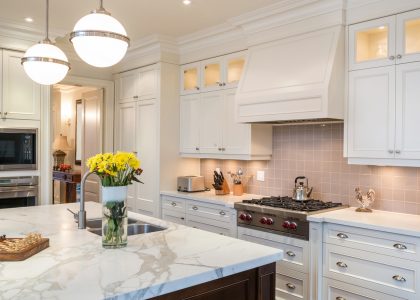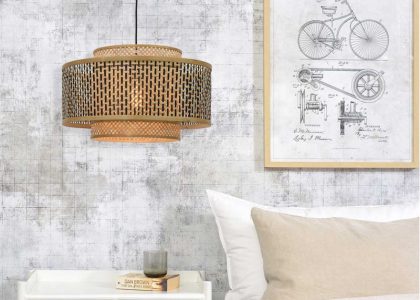Kitchen wall lights are an essential component of any well-designed kitchen. They provide both functional and aesthetic benefits, enhancing the overall ambience of your cooking space. Proper lighting in the kitchen is crucial for a variety of reasons, including illuminating your work area, making it easier to see what you’re doing, creating a safer environment, and adding to the overall design of your kitchen.
Having adequate lighting in the kitchen is essential for performing tasks such as chopping vegetables, reading recipes, and cooking meals. Without proper lighting, it can be challenging to see what you’re doing, leading to potential accidents and mistakes. Kitchen wall lights can help illuminate your work area, ensuring that you have enough light to perform tasks safely and efficiently.
In addition to their functional benefits, kitchen wall lights can also enhance the overall design of your kitchen. They come in a variety of styles and designs, allowing you to choose fixtures that complement your existing decor. Whether you prefer sleek and modern sconces or rustic pendant lights, there are options available to suit every style and preference. By carefully selecting the right lighting fixtures, you can create a cohesive and visually appealing look in your kitchen.
The Benefits of Kitchen Wall Lights
1. Illuminating your work area: One of the primary benefits of kitchen wall lights is their ability to illuminate your work area. Whether you’re chopping vegetables or reading a recipe, having adequate lighting is crucial for performing tasks safely and efficiently. Wall lights can be strategically placed above countertops and workspaces to provide direct light where it’s needed most.
2. Making it easier to see what you’re doing: Proper lighting in the kitchen is essential for seeing what you’re doing. Whether you’re measuring ingredients or checking the doneness of a dish, having enough light is crucial for accuracy. Kitchen wall lights can provide focused and direct light, making it easier to see details and ensuring that you don’t miss any important steps in your cooking process.
3. Creating a safer environment: In addition to making it easier to see what you’re doing, kitchen wall lights also contribute to creating a safer environment. Adequate lighting can help prevent accidents such as cuts and burns by ensuring that you can see potential hazards clearly. By illuminating your work area, you can reduce the risk of accidents and create a safer space for cooking.
4. Adding to the overall design of your kitchen: Kitchen wall lights are not only functional but also add to the overall design of your kitchen. They come in a variety of styles, finishes, and designs, allowing you to choose fixtures that complement your existing decor. Whether you prefer sleek and modern sconces or vintage-inspired pendant lights, there are options available to suit every style and preference. By carefully selecting the right lighting fixtures, you can enhance the aesthetic appeal of your kitchen and create a visually pleasing space.
Types of Kitchen Wall Lights
1. Sconces: Sconces are wall-mounted light fixtures that provide both ambient and task lighting. They come in a variety of styles and designs, from sleek and modern to ornate and traditional. Sconces can be placed above countertops, sinks, or kitchen islands to provide focused light where it’s needed most.
2. Pendants: Pendant lights are suspended from the ceiling and can be used to provide both ambient and task lighting in the kitchen. They come in a variety of shapes, sizes, and styles, allowing you to choose fixtures that match your existing decor. Pendant lights are often used above kitchen islands or dining areas to create a focal point and add visual interest to the space.
3. Track lighting: Track lighting consists of multiple light fixtures mounted on a track that can be adjusted to direct light where it’s needed most. It is a versatile option for kitchens as it allows you to customize the placement and direction of the lights. Track lighting is often used to highlight specific areas or objects in the kitchen, such as artwork or countertops.
4. Under-cabinet lighting: Under-cabinet lighting is installed underneath kitchen cabinets to provide task lighting for countertops and workspaces. It is a popular choice for kitchens as it helps eliminate shadows and provides direct light where it’s needed most. Under-cabinet lighting can be installed using LED strips or individual puck lights, depending on your preference.
Choosing the right lighting fixtures for your kitchen depends on several factors, including the size and layout of your space, your personal style preferences, and the overall design of your kitchen. It’s important to consider both the functionality and aesthetics of the fixtures to ensure that they meet your needs and enhance the overall look of your kitchen.
How to Install Kitchen Wall Lights
Installing kitchen wall lights can be a relatively straightforward process if you have the right tools and materials. Here is a step-by-step guide to help you install kitchen wall lights:
1. Turn off the power: Before starting any electrical work, make sure to turn off the power to the area where you’ll be installing the lights. This can be done by flipping the corresponding circuit breaker in your electrical panel.
2. Gather the necessary tools and materials: To install kitchen wall lights, you’ll need a few basic tools and materials, including a screwdriver, wire strippers, wire connectors, electrical tape, a ladder or step stool (if needed), and the light fixtures themselves.
3. Remove the existing light fixture (if applicable): If you’re replacing an existing light fixture, start by removing it from the wall or ceiling. This may involve unscrewing screws or disconnecting wires, depending on the type of fixture.
4. Install the mounting bracket: Next, install the mounting bracket for your new light fixture. This will typically involve attaching it to the electrical box using screws provided with the fixture.
5. Connect the wires: Once the mounting bracket is in place, connect the wires from the fixture to the corresponding wires in the electrical box. This may involve stripping the ends of the wires, twisting them together, and securing them with wire connectors.
6. Attach the light fixture: Finally, attach the light fixture to the mounting bracket using screws or other hardware provided with the fixture. Make sure it is securely fastened and aligned properly.
7. Test the lights: After installation, turn the power back on and test the lights to ensure they are working properly. If everything is functioning as expected, you can proceed to adjust and position the lights as desired.
It’s important to note that if you’re not comfortable working with electricity or unsure about any step of the installation process, it’s best to hire a professional electrician to ensure a safe and successful installation.
Kitchen Wall Lights and Energy Efficiency
In addition to their functional and aesthetic benefits, kitchen wall lights can also contribute to energy efficiency in your home. By choosing energy-efficient lighting options and implementing smart lighting strategies, you can save money on your electricity bill while still enjoying a well-lit kitchen.
1. How to save money on your electricity bill with energy-efficient lighting: One of the most effective ways to save money on your electricity bill is by choosing energy-efficient lighting options. LED (light-emitting diode) bulbs are a popular choice for kitchen wall lights as they use significantly less energy than traditional incandescent bulbs. LED bulbs are also long-lasting, which means you won’t have to replace them as frequently.
2. LED vs. incandescent bulbs: LED bulbs are more energy-efficient than incandescent bulbs because they convert more of the electricity they consume into light rather than heat. This means that LED bulbs use less energy to produce the same amount of light as incandescent bulbs. Additionally, LED bulbs have a longer lifespan, which means you won’t have to replace them as often, further reducing energy consumption and costs.
3. Dimmer switches: Installing dimmer switches for your kitchen wall lights can also contribute to energy efficiency. Dimmer switches allow you to adjust the brightness of your lights, allowing you to use only the amount of light you need at any given time. This can help reduce energy consumption and extend the lifespan of your bulbs.
Kitchen Wall Lights and Safety

Proper lighting in the kitchen is essential for creating a safe environment and preventing accidents. Here are some tips for ensuring safety in your kitchen with the help of kitchen wall lights:
1. Preventing accidents in the kitchen with proper lighting: Adequate lighting in the kitchen is crucial for preventing accidents such as slips, trips, and falls. By illuminating your work area, you can see potential hazards more clearly and avoid accidents.
2. Tips for avoiding slips, trips, and falls: In addition to proper lighting, there are other measures you can take to prevent slips, trips, and falls in the kitchen. Keep the floor clean and free of clutter, use slip-resistant mats or rugs near sinks and work areas, and ensure that electrical cords are properly secured and out of the way.
3. Fire safety: Kitchen wall lights should be installed at a safe distance from flammable materials such as curtains or cabinets to reduce the risk of fire. It’s also important to choose fixtures that are made from fire-resistant materials and have proper ventilation to prevent overheating.
Kitchen Wall Lights and Design
Kitchen wall lights can add style and personality to your kitchen while enhancing its overall design. Here are some tips for incorporating lighting fixtures that match your decor:
1. Adding style and personality to your kitchen with lighting: Lighting fixtures can serve as decorative elements in your kitchen, adding style and personality to the space. Whether you prefer sleek and modern fixtures or vintage-inspired designs, there are options available to suit every style and preference. Consider the overall design of your kitchen and choose fixtures that complement your existing decor.
2. Choosing the right fixtures to match your decor: When selecting kitchen wall lights, consider the style and color scheme of your kitchen. If you have a modern kitchen with clean lines and minimalistic design, choose fixtures that reflect this aesthetic, such as sleek sconces or pendant lights with a contemporary design. If you have a more traditional or rustic kitchen, opt for fixtures with ornate details or vintage-inspired designs.
3. Creating a cohesive look: To create a cohesive look in your kitchen, choose lighting fixtures that coordinate with other elements in the space, such as cabinet hardware, faucets, and appliances. This will help tie the design together and create a visually appealing and harmonious look.
Kitchen Wall Lights and Functionality
Proper lighting in the kitchen can significantly improve its functionality and make your cooking experience more enjoyable. Here are some ways in which kitchen wall lights can enhance functionality:
1. Improving your cooking experience with proper lighting: Adequate lighting in the kitchen can make a significant difference in your cooking experience. By providing enough light to see what you’re doing, kitchen wall lights can make it easier to prepare meals and follow recipes accurately. Whether you’re chopping vegetables or measuring ingredients, having enough light is crucial for performing tasks safely and efficiently.
2. Making it easier to prepare meals: Kitchen wall lights can make it easier to prepare meals by providing focused and direct light where it’s needed most. Whether you’re working on the stovetop or at the countertop, having adequate lighting can help you see details and ensure that you don’t miss any important steps in your cooking process.
3. Creating a more efficient workspace: Proper lighting in the kitchen can also contribute to creating a more efficient workspace. By illuminating your work area, you can reduce the time and effort required to perform tasks. This can help streamline your cooking process and make it more enjoyable.
Kitchen Wall Lights and Mood
Kitchen wall lights can play a significant role in creating a relaxing and inviting atmosphere in your kitchen. Here are some tips for using lighting to set the mood:
1. Creating a relaxing and inviting atmosphere with lighting: Lighting can have a significant impact on the mood and atmosphere of a space. In the kitchen, you can use lighting to create a warm and inviting ambiance that makes you feel relaxed and comfortable. Consider using warm-toned bulbs or dimmer switches to create a cozy atmosphere.
2. Using dimmer switches to adjust the mood: Dimmer switches are an excellent tool for adjusting the mood in your kitchen. They allow you to control the brightness of your lights, allowing you to create a softer and more intimate ambiance when desired. Dimmer switches are particularly useful for dining areas or kitchen islands where you may want to create a more relaxed atmosphere.
3. Choosing the right color temperature for your space: The color temperature of your kitchen wall lights can also affect the mood of the space. Warm-toned bulbs (around 2700-3000 Kelvin) can create a cozy and inviting atmosphere, while cool-toned bulbs (around 5000-6500 Kelvin) can create a brighter and more energizing ambiance. Consider the overall mood you want to achieve in your kitchen and choose bulbs with the appropriate color temperature.
In conclusion, kitchen wall lights are an essential component of any well-designed kitchen. They provide both functional and aesthetic benefits, enhancing the overall ambience of your cooking space. Proper lighting in the kitchen is crucial for illuminating your work area, making it easier to see what you’re doing, creating a safer environment, and adding to the overall design of your kitchen.
There are various types of kitchen wall lights available, including sconces, pendants, track lighting, and under-cabinet lighting. Choosing the right lighting fixtures for your kitchen depends on several factors, including the size and layout of your space, your personal style preferences, and the overall design of your kitchen.
Installing kitchen wall lights can be a relatively straightforward process if you have the right tools and materials. It’s important to follow a step-by-step guide and take necessary safety precautions to ensure a successful installation.
Kitchen wall lights can also contribute to energy efficiency in your home. By choosing energy-efficient lighting options and implementing smart lighting strategies, you can save money on your electricity bill while still enjoying a well-lit kitchen.
Proper lighting in the kitchen is essential for creating a safe environment and preventing accidents. By illuminating your work area and following safety guidelines, you can reduce the risk of slips, trips, falls, and fire hazards.
In addition to their functional benefits, kitchen wall lights can also enhance the design, functionality, and mood of your kitchen. By carefully selecting fixtures that match your decor, improving functionality with proper lighting, and using lighting to set the mood, you can create a visually appealing, efficient, and inviting space.
Investing in proper lighting for your kitchen is essential for creating a functional and aesthetically pleasing cooking space. Whether you’re renovating your kitchen or simply looking to update your lighting fixtures, consider the benefits of kitchen wall lights and how they can enhance your cooking experience. With the right lighting choices, you can transform your kitchen into a well-lit and stylish space that you enjoy spending time in. Kitchen wall lights provide both task lighting and ambient lighting, making it easier to see what you’re doing while also creating a warm and inviting atmosphere. They can be installed above countertops and work areas to provide focused illumination for tasks such as chopping vegetables or reading recipes. Additionally, kitchen wall lights can be used to highlight architectural features or artwork, adding a touch of elegance to the space. By investing in high-quality fixtures and choosing the right bulbs, you can ensure that your kitchen is well-lit and energy-efficient. Overall, kitchen wall lights are a versatile and practical choice for enhancing the functionality and beauty of your cooking space.
If you’re looking to brighten up your kitchen with some stylish lighting, you won’t want to miss this article on the perfect kitchen wall light. Whether you’re going for a modern, industrial look or a cozy farmhouse vibe, finding the right wall light can make all the difference. Check out this helpful guide on Fitflop Sale UK’s website that offers tips and recommendations for choosing the ideal kitchen wall light that suits your style and needs. From sleek and minimalist designs to vintage-inspired fixtures, this article has got you covered. Don’t miss out on transforming your kitchen into a well-lit and inviting space with the perfect wall light. Click here to read more!





